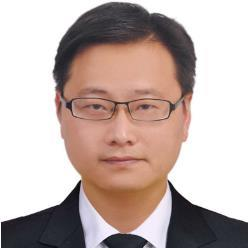Preprint
Article
Fabrication and Evaluation of Carboxymethyl Cellulose/PVA Electrospun Nanofiber Membrane for the Removal of Cu2+ and Cr6+ Ions
Altmetrics
Downloads
332
Views
160
Comments
0
This version is not peer-reviewed
Submitted:
20 April 2023
Posted:
21 April 2023
You are already at the latest version
Alerts
Abstract
CMC/PVA composite nanofiber membrane was prepared by electrostatic spinning method, using carboxymethyl cellulose (CMC) and polyvinyl alcohol (PVA) as raw materials and glutaraldehyde as cross-linking agent. The structure, morphology, thermal stability, and filtration performance of CMC/PVA nanofiber membranes were characterized by advanced instrumental analysis methods such as scanning electron microscopy, Fourier transform infrared spectroscopy, thermogravimetric analysis, ultraviolet analysis and energy spectrum analysis. The results show that the average fiber diameter decreases from 381 nm to 183 nm, when the spinning voltage is 23 KV and the jet speed is 2 µL/min. The obtained fiber has the smallest particle size and the most uniform distribution. Infrared spectroscopy analysis confirms that the adsorption behavior of nanofiber membranes on Cu2+ and Cr6+ is chemical adsorption. The retention rates of CMC/PVA nanofiber membranes for Cu2+ and Cr6+ reached 97% and 98%, respectively.
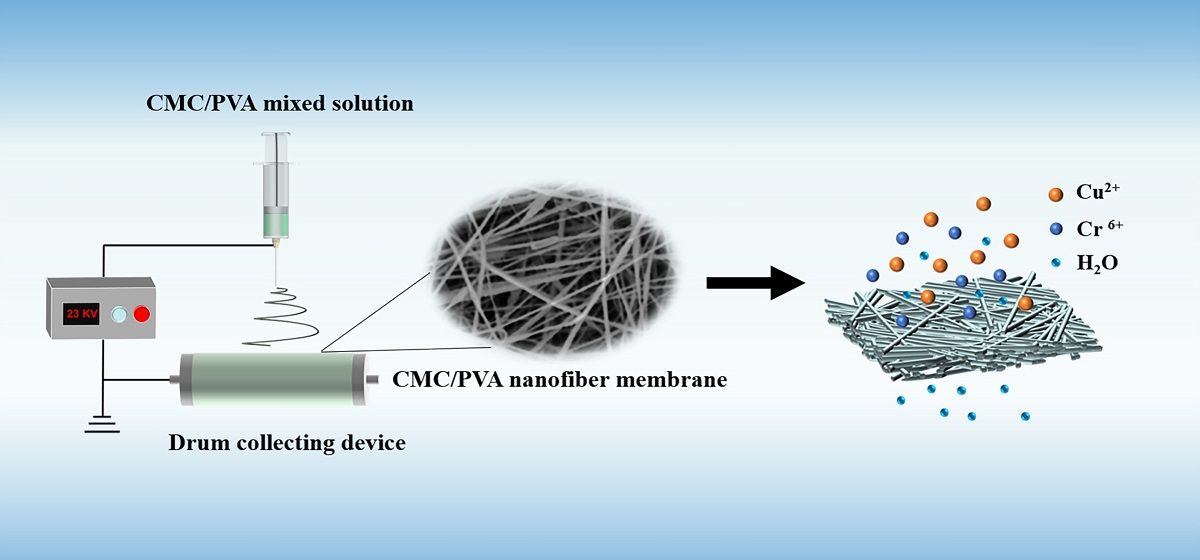
Keywords:
Subject: Chemistry and Materials Science - Materials Science and Technology
1. Introduction
Nowadays, heavy metal pollution in water bodies has become an increasingly serious environmental and public health problem globally [1,2]. There are two main sources of heavy metals in the environment, on the one hand from nature, different rocks contain various heavy metal elements, and soil is differentiated from rocks, which determines the initial content of heavy metals contained in the soil, and processes such as volcanic eruptions, forest fires, wind dusting, etc. make a lot of heavy metal dust float in the air and eventually enter water bodies and soil through dust fall. On the other hand, there is human activity, which is considered to be the main cause of heavy metal pollution of water bodies [3].
There is “toxic, carcinogenic and non-biodegradable” characteristic of heavy metals, thus it can exist in the polluted water environment for a long time, and can be accumulated in organisms through the biomagnification effect of the food chain, ultimately threatening human health [4,5]. Every year, millions of people die from diseases caused by drinking contaminated water. Therefore, how to efficiently remove heavy metal ions from water bodies is an essential problem to be solved in the field of environmental protection. To date, many techniques have been used to remove heavy metal ions from wastewater, including chemical precipitation [6], membrane separation [7], ion exchange [8], adsorption [9]. In recent decades, adsorption membrane filtration technology has become one of themost popular research hotspots. Compared with the traditional adsorption method, it has the characteristics of high efficiency, energy saving, simple operation, modularization, molecular filtration and good effluent quality [10,11]. Accordingly, it is widely used in food, pharmaceutical, biological, chemical, energy, and water treatment fields [12,13].
At present, electrospinning technology is one of the most simple and effective methods to prepare micro and nanofiber membranes [14,15,16]. The diameter of the prepared nanofibers can be adjusted from tens of nanometers to several microns [17,18]. Because of its high surface area, high removal efficiency and strong mechanical properties, electrostatic spinning fibers are widely used in water purification fields such as oil-water separation, heavy metal ion removal and dye removal [19,20]. In addition, electrostatically spun nanofibers can introduce various coordination/chelating groups through surface functionalization, which can easily be separated from wastewater after adsorption of heavy metal ions, effectively reducing wastewater treatment costs and preventing the occurrence of secondary pollution [21,22,23]. In the process of electrostatic spinning, the spinning liquid is loaded into a syringe, and droplets are formed at the orifice of the spinneret by an automatic propulsion device. When voltage is applied, charges are induced in the droplets, as shown in Figure 1. When enough voltage is applied, the droplets are stretched. This stretching leads to the formation of a composite Taylor cone from which a composite jet is ejected and subsequently undergoes stretching by coulomb forces in a high voltage electric field, perturbation, and rapid solidification induced by solvent evaporation to form a nanofiber film on the receiving device. Yang et al. prepared CS nanofiber membrane by electrospinning, and then successfully prepared amine-rich CS-PGMA-PEI electrospinning membrane by grafting PEI in a two-step method, which was used to remove heavy metal ions from aqueous solution [24]. The filtration mechanism was analyzed by XPS. The adsorption process is divided into two processes: one is that negatively charged Cr (VI) (HCrO4- and Cr2O7-) are first adsorbed by protomated amino group; Second, Cr (VI) is reduced to Cr (III) by proton consumption and bonded with CS-PGMA-PEI electrospinning film. The membrane has excellent adsorption and filtration performance and stability, and the maximum adsorption capacity of Cr (VI), Cu (II) and Co (II) reaches 138.96, 69.27 and 68.31 mg/g, respectively. Multi-walled carbon nanotubes (MWCNTs) and electrospinning nanofibers are ideal nanomaterials with great potential in the field of heavy metal ion removal. Deng et al. modified MWCNTs with PEI and then prepared nanofiber membranes by electrospinning embedded polyacrylonitrile (PAN) for removal of heavy metal ions [25]. Compared with pure PAN membrane, MWCNTs/PEI/PAN composite nanofiber membrane has higher mechanical strength, hydrophilicity, permeability and filtration efficiency. The adsorption process is in line with chemisorption. PEI provides additional active sites for composite nanofiber membranes, which makes the adsorption capacity of Pb2+ and Cu2+ ions on composite nanofiber membranes higher than other nanocomposite membranes.
Carboxymethyl cellulose (CMC) is an important cellulose made from natural cellulose by carboxymethylation [26]. Its structure is rich in hydroxyl (-OH) and carboxyl (-COOH), which has strong complexation ability with heavy metal ions in water (such as cadmium, copper and lead) [27]. CMC has the advantages of content abundance, environment friendliness, biodegradability, low cost and strong adsorption capacity, and has broad application prospects in the field of heavy metal adsorption and separation [28,29]. Nevertheless, the presence of a large number of hydrogen bonds in the molecular structure of CMC and its high crystallinity make it difficult to dissolve in common organic solvents, and it is difficult to prepare CMC fiber membranes using electrostatic spinning. Although microfibers can be obtained by electrostatic spinning of aqueous CMC solutions with a certain viscosity, these microfibers have problems such as strong water absorption, poor mechanical properties, and poor moisture resistance, which limit their application [14,30,31]. Therefore, in order to prepare excellent electrospinning nanofiber membranes and improve the stability of CMC nanofiber membrane separation membranes in the process of water purification, physical and chemical modification of CMC is required[32,33].
Typically, other polymers such as polyvinylpyrrolidone (PVP), polyvinyl alcohol (PVA), and Polyethylene glycol (PEG) are added to CMC to improve its mechanical strength and electrospinning processing properties. Polyvinyl alcohol (PVA) is a kind of biodegradable polymer with low cost, high hydrophilicity, good chemical stability and good mechanical resistance. It is widely used in the production of water treatment film, and has remarkable antifouling and excellent filtration performance [34,35,36,37]. The hydroxyl group on the PVA interacts with intermolecular and intramolecular hydrogen bonds. Due to hydrogen bonding, CMC and PVA have strong interaction together. Both polymers have excellent water solubility, which makes them tend to be homogeneous solutions [38]. Hashmi et al. blended CMC and PVA through electrostatic spinning to prepare a nanofiber film with uniform fiber morphology, which overcame the disadvantage that CMC was too viscous to form silk [39]. Compared with pure PVA nanofiber membranes, PVA/CMC nanofibers have higher tensile strength and lower tensile strain, which greatly increases the service life and stability of CMC/PVA nanofiber membranes in extreme environments. Duran-Guerrero et al. prepared nanofiber membranes with different SMON-loading capacities using magnetic nanoparticles (SMON) loaded carboxymethyl cellulose (CMC)/ polyvinyl alcohol (PVA) blends as the carrier by electrospinning [40]. With the increase of SMON content, the diameter of nanofibers becomes finer and more uniform, which is mainly because SMON reduces the interaction between CMC and PVA and increases spinnability.
In this study, CMC/PVA nanofiber membranes were prepared by electrostatic spinning method using carboxymethyl cellulose and polyvinyl alcohol as raw materials. The structural morphology, thermal stability and filtration properties of CMC/PVA nanofiber membranes were analyzed by SEM, FT-IR, TG, UV and EDS characterization methods. The effects of electrostatic spinning voltage and injection speed on the morphology and diameter of nanofiber membranes were investigated, as well as the adsorption characteristics of CMC/PVA nanofiber membranes on Cu2+ and Cr6+ were discussed.
2. Experimental
2.1. Reagents and Instruments
The chemical reagents used in this experiment were all chemically pure, mainly including carboxymethyl cellulose(CMC), polyvinyl alcohol(PVA), copper chloride(CuCl₂), potassium dichromate(K₂Cr₂O₇), sodium diethyl dithiocarbamate and diphenylcarbodihydrazide, which were purchased from Sinopharm Chemical ReagentCo., Ltd.
2.2. Preparation of CMC/PVA Nanofiber Membrane
First, 5 grams of PVA was dissolved in 95 grams of deionized water and stirred in a water bath at 90℃ for 6h to obtain 5 wt% PVA solution. Then, 2g CMC was dissolved in 98 g deionized water and stirred at room temperature and high speed for 3h to obtain 2wt% CMC solution. 5 wt% PVA solution and 2 wt% CMC solution were prepared as 10:1 mass ratio mixed solution, and 1 wt% glutaraldehyde was added, ultrasonic 30min, to get mixed spinning solution. Finally, the mixed PVA/CMC solution was injected into the syringe, and the injection propulsion speed was controlled by the automatic propulsion device. The electrostatic voltage of the device is 17 ~ 23 kV, the receiving distance is 10 cm, and the propulsion speed is 2 μL/min.
2.3. Characterization of CMC/PVA Nanofiber Membranes
Field emission scanning electron microscopy (SEM, Nova Nano 450, FEI, USA) was used to analyze the structure and surface morphology of nanofiber films, and the fiber thickness and distribution were analyzed by ImagieJ software. The thermal stability of nanofiber membranes was analyzed by a comprehensive thermal analyzer (TG, STA 449 F3, NETZSCH, Germany). The nanofiber films were characterized by Fourier Transform infrared absorption spectrometer (FTIR, Nicolet iS10, Thermo Fisher Scientific, USA) in the wavelength range of 4000-500cm-1. Energy dispersion spectrometer (EDS, Octane Plus, Ametek EDAX, USA) was used to analyze the surface elements of metal ion solution before and after nano-fiber membrane filtration.
2.4. Filtration Tests of CMC/PVA Nanofiber Membranes
The separation performance of nanofiber membrane was tested by a vacuum filter device and a sand core filter device. 0.1g sample was taken and fixed on a sand core filter device with a diameter of 4 cm. Prior to the test, the nanofiber membrane was pretreated with deionized water at a pressure of 1 bar for 0.5h to stabilize its water flux. Then 100 mL 1 mg·L-1 Cu2+ and Cr6+ solutions were prepared and filtered under 1 bar pressure, repeated many times. After filtration, the concentration of Cu2+ and Cr6+ in filtrate was determined by UV-visible spectrophotometer (UV, UV-2700, Shimadzu, Japan). All filtration experiments were performed at room temperature. The rejection (R) were calculated by the following Eqs. (1)
Where Cf is the concentration of feed solution and Cp is the concentration of permeate solution.
3. Results and Discussion
3.1. Characteristics of Nanofiber Membranes
Figure 1 describes the preparation strategy of CMC/PVA nanofiber membranes. CMC/PVA homogeneous spinning solution was prepared by mixing CMC and PVA proportionally, and then CMC/PVA nanofiber membrane was prepared by electrospinning method. The voltage is related to the stability of Taylor cone and is one of the decisive factors affecting the morphology of electrospun nanofibers [41,42]. Therefore, we prepared CMC/PVA nanofiber membranes under different voltage conditions. Figure 1 shows the SEM image and diameter distribution of CMC/PVA nanofiber films at different spinning voltages. As can be seen from Figure 2, when the voltage is 17 KV, the nanofibers show obvious beading phenomenon. When the voltage was increased to 23 KV, the bead string phenomenon disappeared and the distribution of the prepared nanofibers was the most uniform. It is speculated that the coulomb force is increased by increasing the voltage, which makes the mixed solution diverge directly into the fiber structure.
Then, Image J software was used to measure the diameters of no less than 20 fibers. The frequency distribution is shown in Figure 1. It can be seen that the nanofibers with the most uniform morphology are mainly distributed between 30 and 80 nm with an average of 52 nm when the voltage is 23kv. At this time, CMC/PVA nanofibers are the smallest, resulting in the largest density, greatly increasing the effective filtration area, which is conducive to the interception of pollutants in water.
Figure 1.
Schematic illustration for the preparation of CMC/PVA nanofiber membrane.
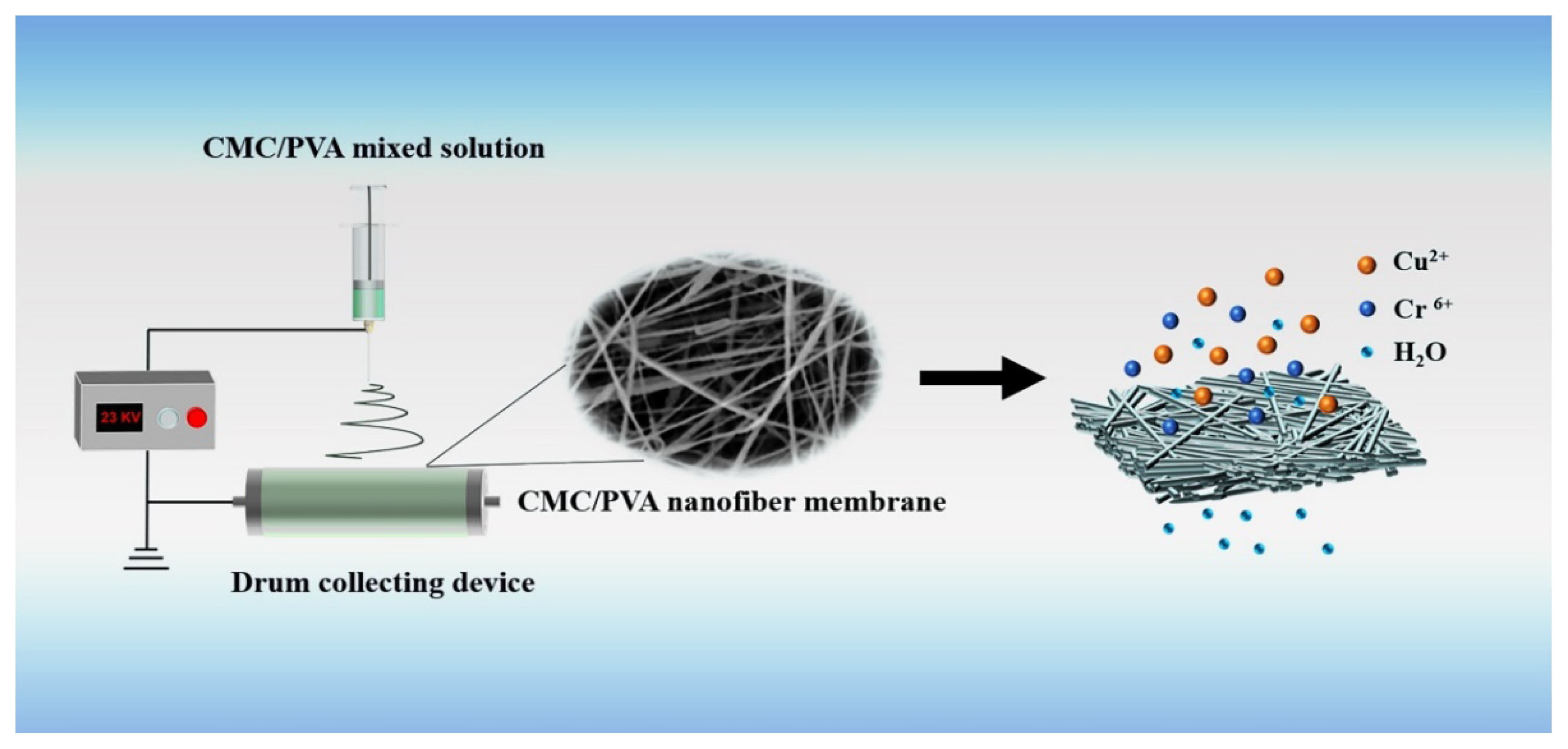
Figure 2.
Surface morphology and direct distribution of CMC/PVA nanofiber membranes under different spinning voltage conditions.
Figure 2.
Surface morphology and direct distribution of CMC/PVA nanofiber membranes under different spinning voltage conditions.
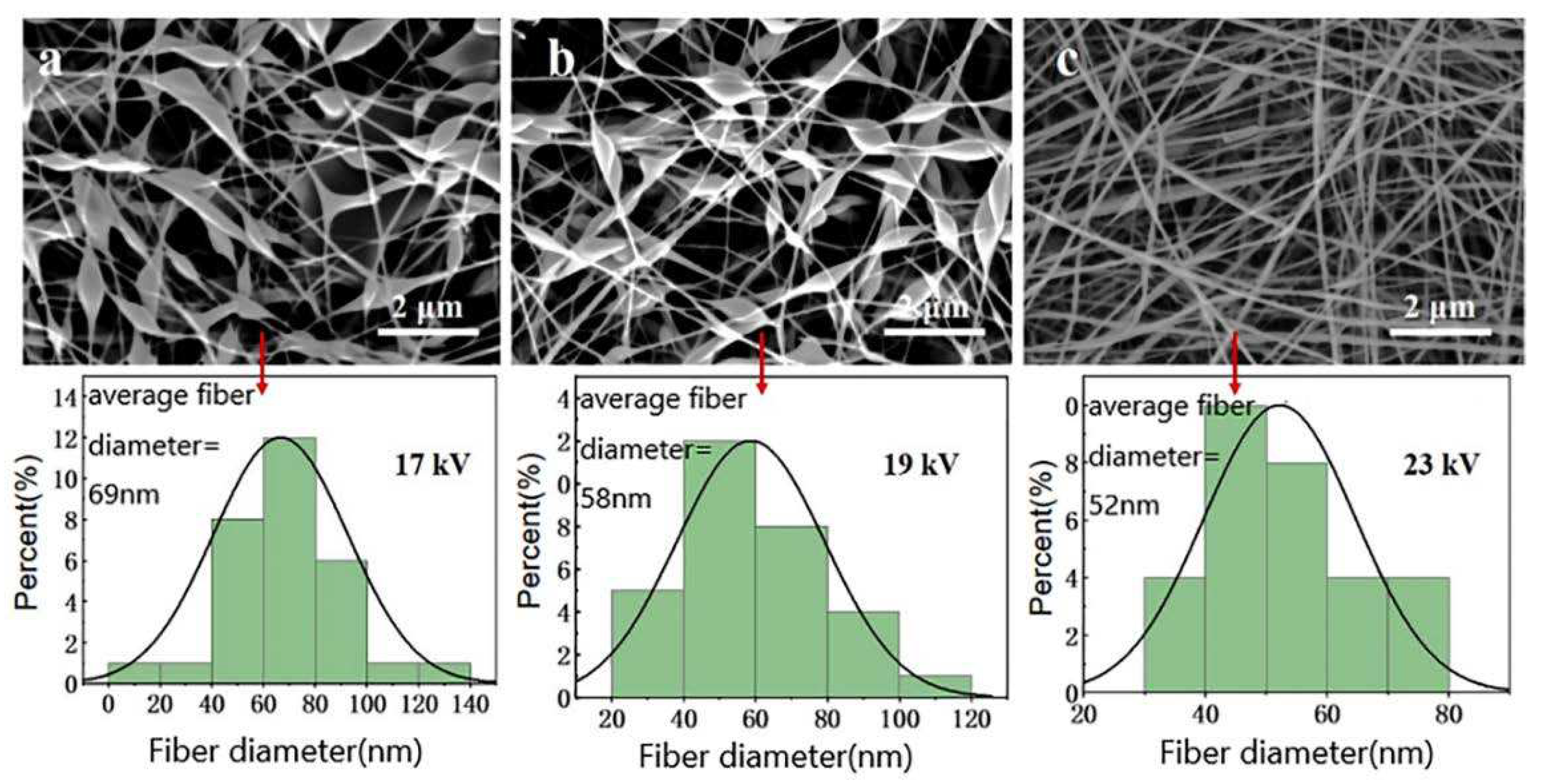
The thermal stability of CMC/PVA nanofiber membrane, CMC and PVA was tested by TG, and the results were shown in Figure 3. It can be seen that the pyrolysis process of CMC/PVA nanofiber film, CMC and PVA is mainly divided into four stages. In the first stage, from room temperature to 52.3℃, CMC/PVA nanofiber membranes, CMC and PVA can all remain stable, and the quality is basically unchanged. In the second stage, the crystal water in the sample gradually evaporated between 52.3 ℃ and 223.3℃, and all three began to lose weight slowly. The weight loss rates of CMC/PVA nanofiber membrane, CMC and PVA were 10%, 10% and 8%, respectively. In the third stage, from 223.3℃ to 288.8℃, it can be seen that the thermal decomposition temperatures of CMC/PVA nanofiber film, CMC and PVA are 263.3℃, 248.3℃ and 252.3℃ respectively, and the weight loss rate reaches the maximum at 288.8℃, 289.8℃ and 263.3℃. At 321.3℃, 321.3℃ and 309.8℃, the weight loss rate slows down, and the residual mass of the three is 36.8%, 36.3% and 53.5%, respectively. This stage is the main stage of sample thermal decomposition, long chain molecules gradually decompose into small molecules and vaporize, resulting in obvious weight loss. The fourth stage is the carbonization stage, during which the remaining final residue is further decomposed to form carbon and ash. Finally, the residual mass of nanofiber membrane, CMC and PVA is 20.4%, 40.4% and 8.91% respectively.
The changes of functional groups before and after CMC/PVA nanofiber membrane filtration were studied by infrared spectroscopy. As shown in Figure 4, for the CMC/PVA nanofiber membrane before filtration, the peak value at 3441 cm-1 corresponds to the N-H tensile vibration. The peak value at 1635 cm-1 corresponds to the bending vibration of the amide I band. The peak value at 1319 cm-1 corresponds to the C-N stretching vibration of amide III band. The peaks at 2920 cm-1 and 1031 cm-1 correspond to the stretching vibration absorption peaks of C-H and C-O, respectively, and the peaks at 1730 cm-1 correspond to the stretching vibration absorption peaks of carboxyl group C=O. After the adsorption and filtration of Cu2+ and Cr6+ by CMC/PVA nanofiber membrane, the absorption peak of C=O tensile vibration disappeared, indicating that there is coordination reaction between heavy metal ions and carboxyl groups in CMC/PVA nanofiber membrane, which proves that the interaction between CMC/PVA nanofiber membrane and heavy metal ions is chemical adsorption.
Figure 5 shows EDS spectra of surface element analysis of nanofiber membrane before and after filtration. It can be clearly seen from Figure 5 that only C and O exist on the surface of CMC/PVA nanofiber membrane before filtration. After filtration, Cu and Cr appear on the surface of CMC/PVA nanofiber membrane, indicating that the CMC/PVA nanofiber membrane can trap Cu2+ and Cr6+ on the surface of the membrane, and achieve efficient removal of heavy metal ions.
3.2. Separation Properties of Nanofiber Membranes
Figure 6a shows the UV absorption curves of 10 groups of Cu2+ solutions measured by UV (concentrations of 0.55, 0.60, 0.65, 0.70, 0.75, 0.80, 0.85, 0.90, 0.95, 1.00 mg/L, respectively). The corresponding standard curve (Figure 6b) was obtained by linear fitting of origin software, and its linear correlation coefficient (R2) was 0.9966. Figure 5c shows the UV absorption spectra before and after Cu2+ filtration. The maximum absorption peak value was substituted into the equation obtained by linear fitting to calculate the solution concentration of Cu2+ before and after filtration, and then the concentration before and after filtration was substituted into equation (1). Finally, the Cu2+ interception rate of the CMC/PVA nanofiber membrane reached 97.2%, showing good adsorption and filtration effects.
Figure 7a shows the UV absorption curves of 10 groups of Cr6+ solutions measured by UV (concentrations of 0.55, 0.60, 0.65, 0.70, 0.75, 0.80, 0.85, 0.90, 0.95, 1.00 mg/L, respectively). The corresponding standard curve (Figure 7b) was obtained by linear fitting of origin software, and its linear correlation coefficient (R2) was 0.9944. Figure 6c shows the UV absorption spectra before and after Cr6+ filtration. By substituting the maximum absorption peak into the equation obtained by linear fitting for calculation, the solution concentration of Cr6+ before and after filtration was obtained, and then the concentration before and after filtration was substituted into equation (1). The results show that the interception rate of Cr6+ by CMC/PVA nanofiber membrane is 98.8%, showing good adsorption and filtration effect. The filtration performance of the nanofiber membrane constructed in this study is compared with that in other studies, as shown in Table 1. The results show that CMC/PVA nanofiber membrane has excellent filtration performance for heavy metal ions.
4. Conclusions
Although carboxymethyl cellulose has excellent adsorption capacity, but its surface tension and viscosity are large, it is difficult to spin alone. The spinnability of carboxymethyl cellulose was increased by adding polyvinyl alcohol. Using carboxymethylcellulose and polyvinyl alcohol as raw materials, deionized water as solvent and glutaraldehyde as crosslinking agent, nanofiber membranes were prepared by electrospinning method. Furthermore, the morphology of nanofibers was optimized by adjusting the solute ratio and solvent concentration, and the experimental parameter was finally determined as 2 wt% CMC solution: 5 wt% PVA solution =1:10, 1wt% glutaraldehyde solution, the working voltage was 23kV, the distance between the receiving device and the spinning device was 10 cm, and the spinning speed was 2 μL·h-1, the nanofiber membrane with uniform and regular morphology was obtained. The micromorphology, physicochemical properties and filtration performance of the nanofiber membrane were characterized and analyzed. The results show that the absorption rates of Cu2+ and Cr6+ of CMC/PVA nanofiber membranes are 97.2% and 98.8%, respectively, which are much higher than those of ordinary commercial ultrafiltration membranes.
Acknowledgments
This work was supported by the National Natural Science Foundation of China (51808263) and the Youth Talent Cultivation Program of Jiangsu University (2018).
References
- Mishra, S.; Bharagava, R. N.; More, N.; Yadav, A.; Zainith, S.; Mani, S.; Chowdhary, P. , Heavy metal contamination: an alarming threat to environment and human health. Environmental biotechnology: For sustainable future 2019, 103–125. [Google Scholar]
- Han, R.; Zhou, B.; Huang, Y.; Lu, X.; Li, S.; Li, N. , Bibliometric overview of research trends on heavy metal health risks and impacts in 1989–2018. J. Cleaner Prod. 2020, 276, 123249. [Google Scholar] [CrossRef]
- Kapoor, D.; Singh, M. P. , Heavy metal contamination in water and its possible sources. In Heavy metals in the environment, Elsevier: 2021; pp 179-189.
- Ali, H.; Khan, E.; Ilahi, I. , Environmental chemistry and ecotoxicology of hazardous heavy metals: environmental persistence, toxicity, and bioaccumulation. J chem 2019, 2019. [Google Scholar] [CrossRef]
- Vardhan, K. H.; Kumar, P. S.; Panda, R. C. , A review on heavy metal pollution, toxicity and remedial measures: Current trends and future perspectives. J. Mol. Liq. 2019, 290, 111197. [Google Scholar] [CrossRef]
- Qasem, N. A.; Mohammed, R. H.; Lawal, D. U. , Removal of heavy metal ions from wastewater: A comprehensive and critical review. Npj Clean Water 2021, 4, 36. [Google Scholar] [CrossRef]
- Qi, Y.; Zhu, L.; Shen, X.; Sotto, A.; Gao, C.; Shen, J. , Polythyleneimine-modified original positive charged nanofiltration membrane: removal of heavy metal ions and dyes. Sep. Purif. Technol. 2019, 222, 117–124. [Google Scholar] [CrossRef]
- Merino-Garcia, I.; Velizarov, S. , New insights into the definition of membrane cleaning strategies to diminish the fouling impact in ion exchange membrane separation processes. Sep. Purif. Technol. 2021, 277, 119445. [Google Scholar] [CrossRef]
- Velusamy, S.; Roy, A.; Sundaram, S.; Kumar Mallick, T. , A review on heavy metal ions and containing dyes removal through graphene oxide-based adsorption strategies for textile wastewater treatment. Chem Rec 2021, 21, 1570–1610. [Google Scholar] [CrossRef]
- Liang, B.; He, X.; Hou, J.; Li, L.; Tang, Z. , Membrane separation in organic liquid: technologies, achievements, and opportunities. Adv. Mater. 2019, 31, 1806090. [Google Scholar] [CrossRef]
- Tijing, L. D.; Dizon, J. R. C.; Ibrahim, I.; Nisay, A. R. N.; Shon, H. K.; Advincula, R. C. , 3D printing for membrane separation, desalination and water treatment. Appl Mater Today 2020, 18, 100486. [Google Scholar] [CrossRef]
- Ni, J.; Yuan, C.; Zheng, J.; Liu, Y. , Distributions, contamination level and ecological risk of heavy metals in surface sediments from intertidal zone of the Sanmen Bay, East China. J. Sea Res. 2022, 190, 102302. [Google Scholar] [CrossRef]
- Pronk, W.; Ding, A.; Morgenroth, E.; Derlon, N.; Desmond, P.; Burkhardt, M.; Wu, B.; Fane, A. G. , Gravity-driven membrane filtration for water and wastewater treatment: a review. Water Res. 2019, 149, 553–565. [Google Scholar] [CrossRef] [PubMed]
- Liu, M.; Cai, N.; Chan, V.; Yu, F. , Development and applications of MOFs derivative one-dimensional nanofibers via electrospinning: a mini-review. Nanomater. 2019, 9(9), 1306. [Google Scholar] [CrossRef] [PubMed]
- Cui, J.; Li, F.; Wang, Y.; Zhang, Q.; Ma, W.; Huang, C. , Electrospun nanofiber membranes for wastewater treatment applications. Sep. Purif. Technol. 2020, 250. [Google Scholar] [CrossRef]
- Wu, S.; Li, K.; Shi, W.; Cai, J. , Chitosan/polyvinylpyrrolidone/polyvinyl alcohol/carbon nanotubes dual layers nanofibrous membrane constructed by electrospinning-electrospray for water purification. Carbohydr. Polym. 2022, 294, 119756. [Google Scholar] [CrossRef] [PubMed]
- Sun, Y.; Cheng, S.; Lu, W.; Wang, Y.; Zhang, P.; Yao, Q. , Electrospun fibers and their application in drug controlled release, biological dressings, tissue repair, and enzyme immobilization. RSC. Adv. 2019, 9, 25712–25729. [Google Scholar] [CrossRef] [PubMed]
- Wu, J.; Zhang, Z.; Zhou, W.; Liang, X.; Zhou, G.; Han, C. C.; Xu, S.; Liu, Y. , Mechanism of a long-term controlled drug release system based on simple blended electrospun fibers. J. Controlled. Release. 2020, 320, 337–346. [Google Scholar] [CrossRef]
- Zhou, Y.; Liu, Y.; Zhang, M.; Feng, Z.; Yu, D.-G.; Wang, K. , Electrospun nanofiber membranes for air filtration: A review. Nanomater. 2022, 12, 1077. [Google Scholar] [CrossRef]
- Farokhi, M.; Mottaghitalab, F.; Reis, R. L.; Ramakrishna, S.; Kundu, S. C. , Functionalized silk fibroin nanofibers as drug carriers: Advantages and challenges. J. Controlled. Release. 2020, 321, 324–347. [Google Scholar] [CrossRef]
- Wu, W.; Zhang, X.; Qin, L.; Li, X.; Meng, Q.; Shen, C.; Zhang, G. , Enhanced MPBR with polyvinylpyrrolidone-graphene oxide/PVDF hollow fiber membrane for efficient ammonia nitrogen wastewater treatment and high-density Chlorella cultivation. Chem. Eng. J. 2020, 379, 122368. [Google Scholar] [CrossRef]
- Zou, P.; Lee, W.-H.; Gao, Z.; Qin, D.; Wang, Y.; Liu, J.; Sun, T.; Gao, Y. , Wound dressing from polyvinyl alcohol/chitosan electrospun fiber membrane loaded with OH-CATH30 nanoparticles. Carbohydr. Polym. 2020, 232, 115786. [Google Scholar] [CrossRef] [PubMed]
- Deng, Y.; Lu, T.; Cui, J.; Samal, S. K.; Xiong, R.; Huang, C. , Bio-based electrospun nanofiber as building blocks for a novel eco-friendly air filtration membrane: A review. Sep. Purif. Technol. 2021, 277, 119623. [Google Scholar] [CrossRef]
- Yang, D.; Li, L.; Chen, B.; Shi, S.; Nie, J.; Ma, G. , Functionalized chitosan electrospun nanofiber membranes for heavy-metal removal. Polymer. 2019, 163, 74–85. [Google Scholar] [CrossRef]
- Deng, S.; Liu, X.; Liao, J.; Lin, H.; Liu, F. , PEI modified multiwalled carbon nanotube as a novel additive in PAN nanofiber membrane for enhanced removal of heavy metal ions. Chem. Eng. J. 2019, 375. [Google Scholar] [CrossRef]
- Rahman, M. M.; Alam, M.; Rahman, M. M.; Susan, M. A. B. H.; Shaikh, M. A. A.; Nayeem, J.; Jahan, M. S. , A novel approach in increasing carboxymethylation reaction of cellulose. Carbohydr. Polym. Technol. Appl. 2022, 4, 100236. [Google Scholar] [CrossRef]
- Hamdan, M. A.; Ramli, N. A.; Othman, N. A.; Amin, K. N. M.; Adam, F. , Characterization and property investigation of microcrystalline cellulose (MCC) and carboxymethyl cellulose (CMC) filler on the carrageenan-based biocomposite film. Mater. Today: Proc. 2021, 42, 56–62. [Google Scholar] [CrossRef]
- Mohamadpour, F. , Carboxymethyl cellulose (CMC) as a recyclable green catalyst promoted eco-friendly protocol for the solvent-free synthesis of 1 H-pyrazolo [1, 2-b] phthalazine-5, 10-dione derivatives. Polycyclic. Aromat. Compd. 2022, 42, 1091–1102. [Google Scholar] [CrossRef]
- Allafchian, A.; Hosseini, H.; Ghoreishi, S. M. , Electrospinning of PVA-carboxymethyl cellulose nanofibers for flufenamic acid drug delivery. Int. J. Biol. Macromol. 2020, 163, 1780–1786. [Google Scholar] [CrossRef]
- Shen, H.; Li, Y.; Yao, W.; Yang, S.; Yang, L.; Pan, F.; Chen, Z.; Yin, X. , Solvent-free cellulose nanocrystal fluids for simultaneous enhancement of mechanical properties, thermal conductivity, moisture permeability and antibacterial properties of polylactic acid fibrous membrane. Compos. Part B: Eng. 2021, 222, 109042. [Google Scholar] [CrossRef]
- Wang, C.; Zhao, J.; Liu, L.; Zhang, P.; Wang, X.; Yu, J.; Ding, B. , Transformation of fibrous membranes from opaque to transparent under mechanical pressing. Eng. 2021. [Google Scholar] [CrossRef]
- Mazuki, N.; Majeed, A. A.; Nagao, Y.; Samsudin, A. , Studies on ionics conduction properties of modification CMC-PVA based polymer blend electrolytes via impedance approach. Polym. Test. 2020, 81, 106234. [Google Scholar] [CrossRef]
- Al-Shamari, A.; Abdelghany, A.; Alnattar, H.; Oraby, A. , Structural and optical properties of PEO/CMC polymer blend modified with gold nanoparticles synthesized by laser ablation in water. J. Mater. Res. Technol. 2021, 12, 1597–1605. [Google Scholar] [CrossRef]
- Behdarvand, F.; Valamohammadi, E.; Tofighy, M. A.; Mohammadi, T. , Polyvinyl alcohol/polyethersulfone thin-film nanocomposite membranes with carbon nanomaterials incorporated in substrate for water treatment. J. Environ. Chem. Eng. 2021, 9(1), 104650. [Google Scholar] [CrossRef]
- Cui, Z.; Zheng, Z.; Lin, L.; Si, J.; Wang, Q.; Peng, X.; Chen, W. , Electrospinning and crosslinking of polyvinyl alcohol/chitosan composite nanofiber for transdermal drug delivery. Adv. Polym. Tech. 2018, 37, 1917–1928. [Google Scholar] [CrossRef]
- Raksa, A.; Numpaisal, P.-o.; Ruksakulpiwat, Y. , The effect of humidity during electrospinning on morphology and mechanical properties of SF/PVA nanofibers. Mater. Today: Proc. 2021, 47, 3458–3461. [Google Scholar] [CrossRef]
- Unal, B.; Yalcinkaya, E. E.; Demirkol, D. O.; Timur, S. , An electrospun nanofiber matrix based on organo-clay for biosensors: PVA/PAMAM-Montmorillonite. Appl. Surf. Sci. 2018, 444, 542–551. [Google Scholar] [CrossRef]
- Khan, M. Q.; Kharaghani, D.; Ullah, S.; Waqas, M.; Abbasi, A. M. R.; Saito, Y.; Zhu, C.; Kim, I. S. , Self-cleaning properties of electrospun PVA/TiO2 and PVA/ZnO nanofibers composites. Nanomater. 2018, 8, 644. [Google Scholar] [CrossRef]
- Hashmi, M.; Ullah, S.; Ullah, A.; Saito, Y.; Haider, M. K.; Bie, X.; Wada, K.; Kim, I. S. , Carboxymethyl Cellulose (CMC) Based Electrospun Composite Nanofiber Mats for Food Packaging. Polym. 2021, 13(2). [Google Scholar] [CrossRef]
- Duran-Guerrero, J. G.; Martinez-Rodriguez, M. A.; Garza-Navarro, M. A.; Gonzalez-Gonzalez, V. A.; Torres-Castro, A.; De La Rosa, J. R. , Magnetic nanofibrous materials based on CMC/PVA polymeric blends. Carbohydr. Polym. 2018, 200, 289–296. [Google Scholar] [CrossRef]
- Angel, N.; Guo, L.; Yan, F.; Wang, H.; Kong, L. , Effect of processing parameters on the electrospinning of cellulose acetate studied by response surface methodology. J. Agric. Food Res. 2020, 2. [Google Scholar] [CrossRef]
- Bakar, S. S. S.; Fong, K. C.; Eleyas, A.; Nazeri, M. F. M. , Effect of Voltage and Flow Rate Electrospinning Parameters on Polyacrylonitrile Electrospun Fibers. IOP Conf. Ser.: Mater. Sci. Eng. 2018, 318. [Google Scholar] [CrossRef]
- Liu, W.; Wang, D.; Soomro, R. A.; Fu, F.; Qiao, N.; Yu, Y.; Wang, R.; Xu, B. , Ceramic supported attapulgite-graphene oxide composite membrane for efficient removal of heavy metal contamination. J. Membr. Sci. 2019, 591, 117323. [Google Scholar] [CrossRef]
- Elessawy, N. A.; Gouda, M. H.; Elnouby, M.; Ali, S. M.; Salerno, M.; Youssef, M. E. , Sustainable Microbial and Heavy Metal Reduction in Water Purification Systems Based on PVA/IC Nanofiber Membrane Doped with PANI/GO. Polym. 2022, 14, 1558. [Google Scholar] [CrossRef] [PubMed]
- Hezarjaribi, M.; Bakeri, G.; Sillanpaa, M.; Chaichi, M. J.; Akbari, S.; Rahimpour, A. , Novel adsorptive PVC nanofibrous/thiol-functionalized TNT composite UF membranes for effective dynamic removal of heavy metal ions. J. Environ. Manage. 2021, 284, 111996. [Google Scholar] [CrossRef]
- Wang, H.; Xu, H.; Li, H.; Liu, X.; Du, Z.; Yu, W. , Electrospun Polyurethane/Zeolitic Imidazolate Framework Nanofibrous Membrane with Superior Stability for Filtering Performance. ACS Appl. Polym. Mater. 2020, 3, 710–719. [Google Scholar] [CrossRef]
- Zhang, X.; Jin, P.; Xu, D.; Zheng, J.; Zhan, Z.-M.; Gao, Q.; Yuan, S.; Xu, Z.-L.; Van der Bruggen, B. , Triethanolamine modification produces ultra-permeable nanofiltration membrane with enhanced removal efficiency of heavy metal ions. J. Membr. Sci. 2022, 644, 120127. [Google Scholar] [CrossRef]
- Abdulkarem, E.; Ibrahim, Y.; Kumar, M.; Arafat, H. A.; Naddeo, V.; Banat, F.; Hasan, S. W. , Polyvinylidene fluoride (PVDF)-α-zirconium phosphate (α-ZrP) nanoparticles based mixed matrix membranes for removal of heavy metal ions. Chemosphere. 2021, 267, 128896. [Google Scholar] [CrossRef]
- Pei, X.; Gan, L.; Tong, Z.; Gao, H.; Meng, S.; Zhang, W.; Wang, P.; Chen, Y. , Robust cellulose-based composite adsorption membrane for heavy metal removal. J. Hazard. Mater. 2021, 406, 124746. [Google Scholar] [CrossRef]
- Kamari, S.; Shahbazi, A. , High–performance nanofiltration membrane blended by Fe3O4@ SiO2–CS bionanocomposite for efficient simultaneous rejection of salts/heavy metals ions/dyes with high permeability, retention increase and fouling decline. Chem. Eng. J. 2021, 417, 127930. [Google Scholar] [CrossRef]
Figure 3.
TG curves :(a) CMC, (b) CMC/PVA nanofiber membrane and (c) PVA.
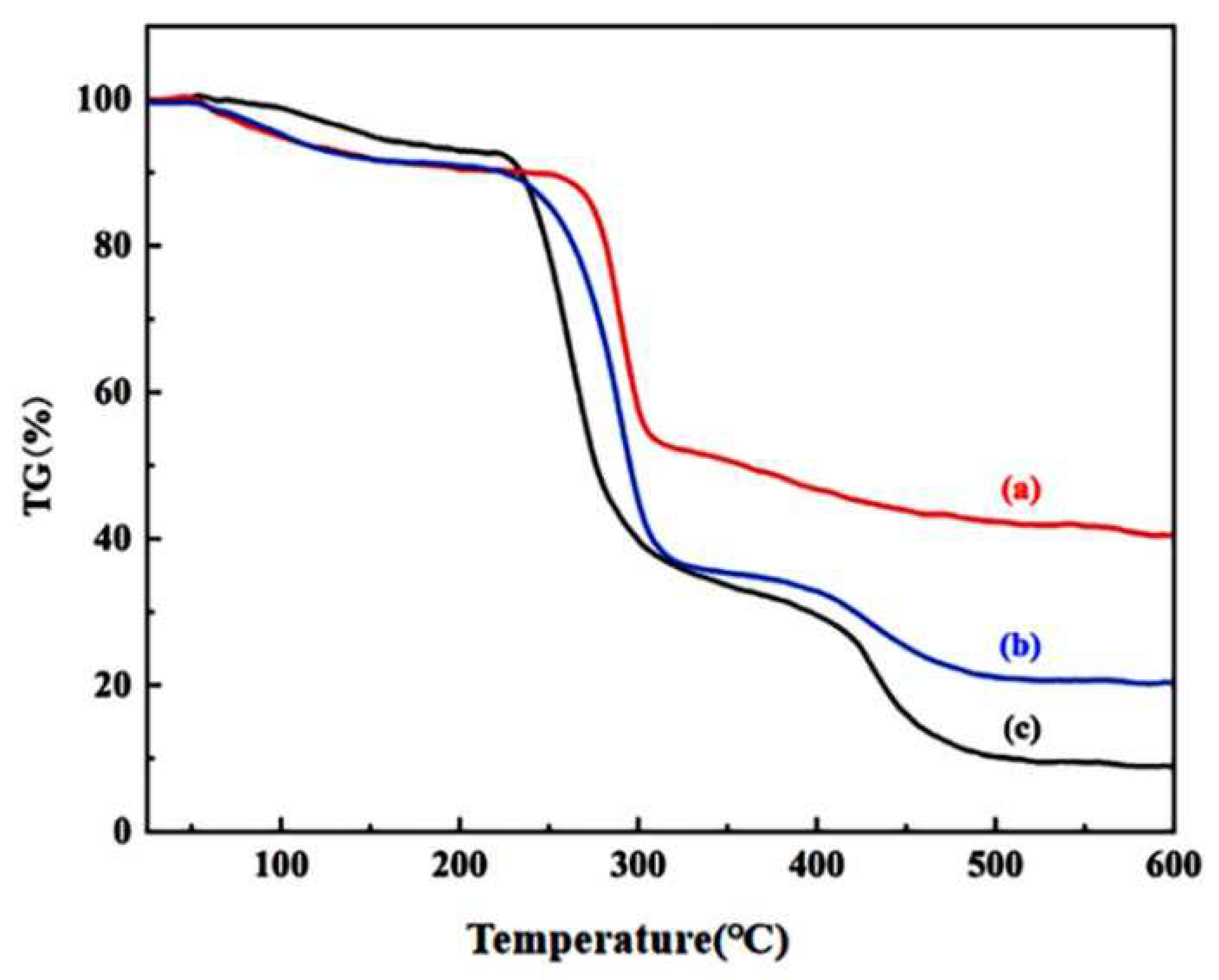
Figure 4.
FT-IR spectra of CMC/PVA nanofiber membrane before and after filtration of heavy metal ions: (a) CMC/PVA fiber membrane before filtration, (b) CMC/PVA fiber membrane after filtration.
Figure 4.
FT-IR spectra of CMC/PVA nanofiber membrane before and after filtration of heavy metal ions: (a) CMC/PVA fiber membrane before filtration, (b) CMC/PVA fiber membrane after filtration.
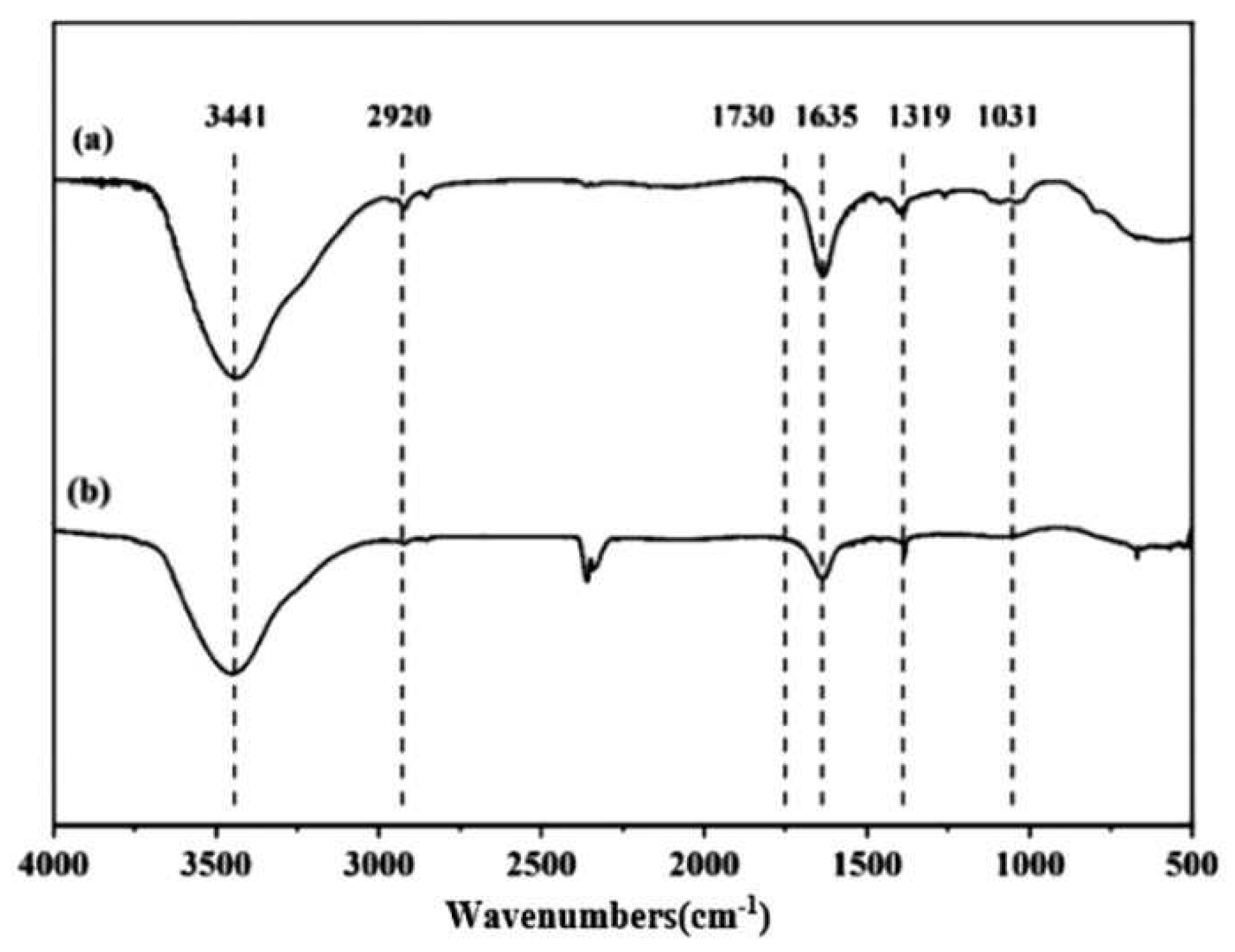
Figure 5.
EDS spectra of CMC/PVA nanofiber membrane before and after filtration of heavy metal ions: (a) CMC/PVA fiber membrane before filtration, (b) CMC/PVA fiber membrane after filtration.
Figure 5.
EDS spectra of CMC/PVA nanofiber membrane before and after filtration of heavy metal ions: (a) CMC/PVA fiber membrane before filtration, (b) CMC/PVA fiber membrane after filtration.
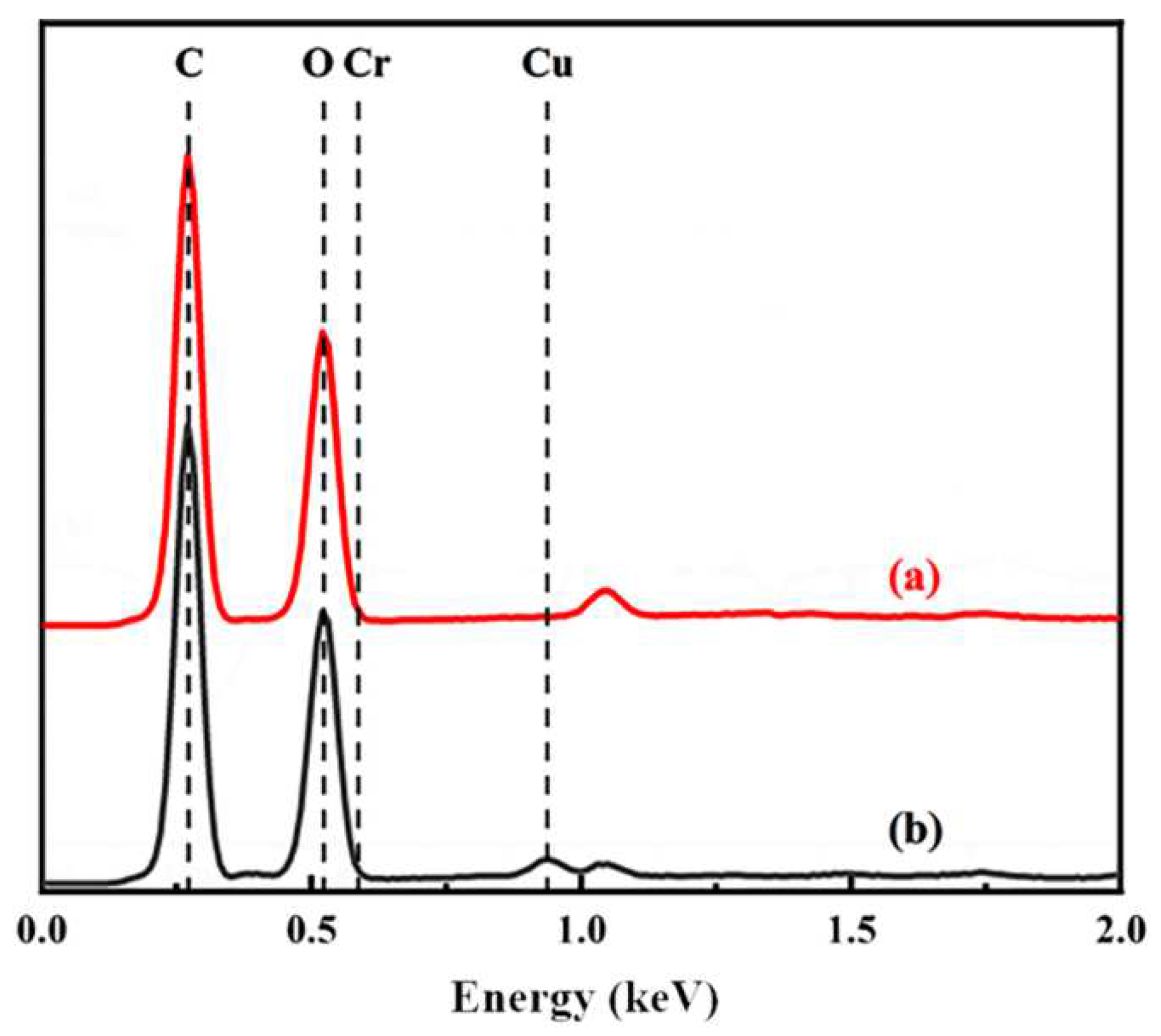
Figure 6.
UV absorption curves of ten groups of Cu2+ standard solutions at 55 mg/L ~ 1 mg/L(a) standard curves, (b) a linear fit to the standard curve of Cu2+ and (c) filtration effect of CMC/PVA nanofiber membrane on Cu2+.
Figure 6.
UV absorption curves of ten groups of Cu2+ standard solutions at 55 mg/L ~ 1 mg/L(a) standard curves, (b) a linear fit to the standard curve of Cu2+ and (c) filtration effect of CMC/PVA nanofiber membrane on Cu2+.

Figure 7.
UV absorption curves of ten groups of Cr6+ standard solutions at 55 mg/L ~ 1 mg/L(a) standard curves, (b) a linear fit to the standard curve of Cr6+ and (c) filtration effect of CMC/PVA nanofiber membrane on Cr6+.
Figure 7.
UV absorption curves of ten groups of Cr6+ standard solutions at 55 mg/L ~ 1 mg/L(a) standard curves, (b) a linear fit to the standard curve of Cr6+ and (c) filtration effect of CMC/PVA nanofiber membrane on Cr6+.

Table 1.
Comparison of adsorption performance by some nanofibrous membranes.
| Membrane type | Heavy metal ion | Rejection rate | Reference |
|---|---|---|---|
| GO/Attapulgite/ Al2O3 | Cu2+ | 99.9% | [43] |
| PVA/IC/PANI/GO | Pb2+、Cd2+ | 97.19%、91.4% | [44] |
| PVC/TNT | Cu2+、Ni2+ | 90%、86.7% | [45] |
| PU/ZIF | Cr6+ | 85% | [46] |
| PEI/TMC | Zn2+、Cd2+、Ni2+、Cu2+ | 97% | [47] |
| PVDF/α-ZrP | Cu2+ 、Pb2+ | 93.1%、91.2% | [48] |
| CA/ P(MA-co-AA)/PEI | Cu2+ | 97.4% | [49] |
| CS/Fe3O4@SiO2 | Cu2+ 、Pb2+ | 98.61%、98.11% | [50] |
| CMC/PVA | Cu2+、Ni2+ | 97.2%、98.8% | This work |
Disclaimer/Publisher’s Note: The statements, opinions and data contained in all publications are solely those of the individual author(s) and contributor(s) and not of MDPI and/or the editor(s). MDPI and/or the editor(s) disclaim responsibility for any injury to people or property resulting from any ideas, methods, instructions or products referred to in the content. |
© 2023 by the authors. Licensee MDPI, Basel, Switzerland. This article is an open access article distributed under the terms and conditions of the Creative Commons Attribution (CC BY) license (http://creativecommons.org/licenses/by/4.0/).
Copyright: This open access article is published under a Creative Commons CC BY 4.0 license, which permit the free download, distribution, and reuse, provided that the author and preprint are cited in any reuse.
MDPI Initiatives
Important Links
© 2024 MDPI (Basel, Switzerland) unless otherwise stated


